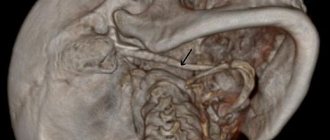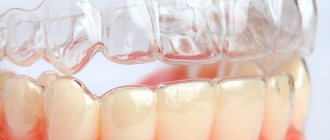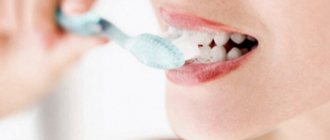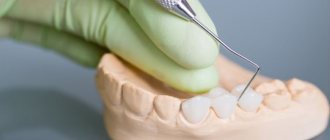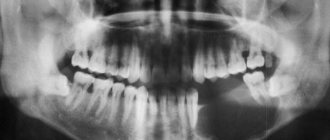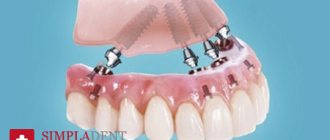- Crooked teeth
- The appearance of a second row of teeth in the jaw
- When permanent teeth do not appear for a long time
- How to distinguish baby teeth from permanent ones?
The complex process of replacing baby teeth with permanent ones is often painful and accompanied by a number of problems. The most common of them is malocclusion. The second most common problem is the appearance of a second set of teeth. Also, many parents are faced with the fact that their child’s molars and incisors do not appear for a very long time.
Formation of permanent teeth
Molars are formed from the epithelial dental plate. The appearance of their rudiments occurs only closer to the 5th month of fetal development inside the mother’s womb.
There are two groups of molars:
- Substitutes. This includes canines, incisors and premolars, which have temporary analogues.
- Additional. This group includes molars that do not have milk predecessors.
The growth of the primordial teeth of the replacement type occurs in the same alveolus as the temporary teeth; they are located behind the lingual surface of the primary teeth. Only after some time does the volume of bone tissue increase, ensuring their insulation.
Additional teeth are formed only after a year, since for this the jaw must reach the appropriate size.
At what age do they appear?
Statistics show that the beginning and completion of the change from temporary teeth to molars in most children occurs at approximately the same time. There are minimal differences only among children in different regions. The warmer the climate, the sooner the child will have permanent teeth.
The table shows age parameters that can be used to determine the approximate beginning of the eruption of molars according to several well-known authors.
| Set of teeth | Period of eruption of permanent teeth in children (in years) | ||
| according to Vinogradova | according to Lukomsky | according to Novak | |
| Central incisors | 5-6 | 6-9 | 6-9 |
| Lateral incisors | 7-9 | 7-10 | 7-10 |
| Fangs | 12-13 | 9-14 | 9-14 |
| First premolars | 9-11 | 9-13 | 9-13 |
| Second premolars | 9-11 | 9-15 | 10-14 |
| First molars | 4,5-7 | 7-8 | 5-8 |
| Second molars | 12-13 | 10-15 | 10-14 |
| Third molars | 18-25 | 15-24 | 18-20 |
The differences in the age at which permanent teeth appear depending on the author are due to the fact that they present the results of studies in different regions that were carried out with a serious difference in time (several decades).
Photos of fangs in children
Help the project, share your review 
2
Join the discussion of the article:
Natalia
We are currently in the midst of an active teething period for our youngest daughter, and the process is extremely difficult: conjunctivitis, fever, reluctance to smile. By luck I came across this article. Thank you very much for the enlightenment! We went to see the dentist and it turned out that we had a tooth coming out, but it never would have occurred to me, I was looking for problems from the outside. Now let's pay attention to the process of teeth growth.
Vote for0Vote against Reply
Igor
As a child, I also had fangs, but then somehow it happened that they disappeared by themselves. I didn’t go to dentists because I was terribly afraid of them and endured any pain. I don’t think this is a serious problem, but if there is severe pain, it is best to consult a dentist, because not everyone is able to endure toothache, especially at a time when fangs are growing.
Vote for0Vote against Reply
Site search
Recommendations
Unusual crafts for children - ideas, tips, photo examples
Sangviritrin - instructions for use of the solution and indications for use for dental problems
Mouth spray: the best formulations with prebiotics, their cost and application features
Falimint - reviews, instructions for use and expert assessment of effectiveness
Stomatofit - complete instructions for use, dosage, selection of analogues and price comparison
Ketorol for toothache - reviews of use and effectiveness. Cost and dentists’ opinions about the medicine
Antibiotics for flux: the most effective remedies and tips on choosing medications for children and adults
Metrogil denta - analogues, advantages of use, composition features and indications for use
Bathroom vanity unit – choose the best option. Photo of design, combination, sizes, color
Periodontocide - means for prevention, release form, methods of application and indications for use
Medicine for teeth - rating of the best remedies for eliminating pain and relieving swelling. Doctors' advice and cost of the most effective drugs
Medicine for gums - the most effective gels, ointments and tablets for relieving pain and discomfort
Curtains made of beads - what is their feature? Photo of beautiful design + installation instructions
Blue for stomatitis - methods and features of using the medicine for children and adults
Cholisal is a dental gel for gums and oral cavity. Price and instructions for use
Kamistad gel - instructions for use, features of use, composition, indications and contraindications
Lincomycin - instructions for use, cost, reviews from patients and doctors
Ointment for gums - the choice of the most effective healing and anti-inflammatory agents
Ibuprofen - clinical practice, instructions for use and safety tips
Pain after wisdom tooth removal - possible complications and duration of pain after removal
Sections
Most read on the site:
A tooth hurts at night The sky in the mouth hurts Vitamins for teeth Inflammation of the gums Inflammation of the tooth Gel for gums Herpes in the mouth Dental hygiene Gorpils Dekasan Dental floss Tartar Plaque Ibuprofen Irrigator How to choose a mouthwash How to brush your teeth Kamistad gel Bleeding gums Medicine for gums Medicine for teeth Cavity treatment mouth Lincomcin ointment for gum metrogil denta nystatin swollen upper lip whitening paste gums gums periodontocide Prevention Pomic in the mouth Solution to the oral cavity of Sinki sinky from stomatitis spray spray stomatophytite dentistry in the gums, ultrasound halitosis Hepilor Holisal Crunches the jaw Itchy teeth Cleaning gums Splinting teeth Mouth ulcers
Copyright © 2022 ZubkiExpert.Ru is a leading online portal about dentistry. Modern methods of diagnostics and dental treatment! Home | Sitemap | Dentist consultation
Teething sequence
Almost all parents believe that the first molars should be incisors, which replace temporary elements of the dentition. But this opinion is wrong. Even before baby teeth fall out, at the age of 5-6 years, children receive their first molars, which are not on the list of primary teeth.
After this, the sequence of formation of a permanent bite is almost no different from the order of eruption of primary teeth:
- the lower and upper central incisors grow;
- lateral incisors appear on both jaws;
- lower and upper first premolars;
- fangs;
- upper and lower second premolars;
- second and third molars (you must understand that the so-called “wisdom teeth” sometimes do not penetrate the surface of the gums at all).
Teeth cutting in this order does not happen just like that, because it ideally corresponds to the speed of development and formation of the maxillofacial system. If the optimal sequence is followed, correct bite development occurs.
Content:
- Why is it necessary to replace baby teeth with permanent ones?
- When do the first baby teeth fall out?
- Which baby teeth fall out first?
- Drop order
- At what age do radical units appear?
- Possible abnormalities in the child
- Why do empty spaces remain unoccupied for a long time?
As the child grows, the baby teeth are replaced by permanent ones. This is a natural process, without which the full functioning of the dentofacial apparatus is impossible. But parents should treat it with the utmost responsibility, since very often violations in the sequence of loss of temporary units cause serious malocclusions that have to be treated in the future.
Duration of growth
Typically, children say goodbye to their last temporary teeth at about 12-13 years of age, although the roots of baby teeth dissolve even earlier. By that time, the oral cavity already has molars that are actively growing, and their roots are at different stages of formation.
It is necessary to understand the approximate timing of growth and root formation in case of deviations. It is these indicators that are taken into account when choosing a treatment method.
Experts distinguish two main stages of development of the roots of permanent teeth:
- Stage of unformed apex.
- Unclosed apex stage.
At the first stage, the length of the root becomes maximum, but its walls are parallel to each other. The channel is of sufficient width; it ends in the area of the future apex with a bell. The periodontal gap can be seen only on the sides of the tooth root.
At the next stage, there is a gradual formation of the upper part of the root, the convergence of the root walls and the release of the periodontal fissure, the apical region of which is slightly enlarged.
The completion of tooth root formation occurs at approximately this age:
| Teeth | Upper jaw, age | Lower jaw, age |
| Central incisors | 9-13 | 7-11 |
| Lateral incisors | 9-12 | 8-11 |
| Fangs | 9-12 | 9-12 |
| First premolars | 11-13 | 11-13 |
| Second premolars | 11-13 | 11-13 |
| First molars | 9-12 | 9-12 |
| Second molars | 14-15 | 14-15 |
Since the eruption of third molars does not occur at a specific time, it is impossible to establish a clear age at which their roots are formed.
X-ray results confirm the completion of the process of tooth root formation. The key signs are the absence of an opening at the apex, as well as a pronounced periodontal contour.
Thus, completion of dental growth, including full maturation, usually occurs only between the ages of 15 and 18 years. It is at this time that the maxillofacial apparatus already has the same dimensions as in adults.
Eye teeth in teenagers
The permanent lower eye teeth are formed at the age of 9-10 years. The upper fangs appear after 1-2 years.
In a healthy child, the formation of permanent eye teeth is painless. If this process is accompanied by pain, then this indicates a serious problem. This usually happens if diseases of the oral cavity occur, such as gumboil, pulpitis, periodontitis or other inflammatory processes. In such a situation, you should not try to get rid of the problem yourself. The most you can do is take a painkiller and immediately go to the dentist.
